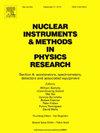Characterisation of radioactive decay series by digital autoradiography, part 2: Experimental evidence of time and space coincidences (TSCs) on geo-materials
IF 1.5
3区 物理与天体物理
Q3 INSTRUMENTS & INSTRUMENTATION
Nuclear Instruments & Methods in Physics Research Section A-accelerators Spectrometers Detectors and Associated Equipment
Pub Date : 2025-03-20
DOI:10.1016/j.nima.2025.170439
引用次数: 0
Abstract
The BeaQuant gas detector is a real-time digital autoradiography system that sequentially acquires alpha and beta emissions from natural decay chains. Each emission is identified according to the type of particle emitted (alpha or beta), and the time and position of emergence in two dimensions. The experimental data generated were interpreted using an algorithm to identify Time and Space Coincidences (TSCs). Three different TSCs were detected on a thin section of uranium ore at secular equilibrium. These α/α, α/α/α and β/α coincidences come from three short-lived radionuclides: 215Po and 219Rn in the 235U chain, and 214Po in the 238U chain. The distribution of the differences in arrival times of the particles forming a coincidence was analysed in terms of half-life. This analysis confirmed that these three coincidences originated from these three radionuclides, the periods having been found experimentally. The theoretical calculations of the number of coincidences confirm those obtained by the algorithm for analysing the experimental autoradiographic data.
用数字放射自显影法描述放射性衰变系列,第2部分:地质材料的时间和空间巧合(tsc)的实验证据
BeaQuant气体探测器是一种实时数字放射自成像系统,可以从自然衰变链中顺序获取α和β辐射。每次发射都是根据发射的粒子类型(α或β)以及在二维中出现的时间和位置来识别的。生成的实验数据使用一种算法进行解释,以确定时间和空间巧合(TSCs)。在长期平衡状态下的铀矿石薄片上检测到三种不同的tsc。这些α/α、α/α/α和β/α的巧合来自三种短寿命放射性核素:235U链上的215Po和219Rn,以及238U链上的214Po。从半衰期的角度分析了形成巧合的粒子到达时间的差异分布。这一分析证实,这三个巧合源于这三种放射性核素,这些周期是通过实验发现的。巧合数的理论计算与实验自放射成像数据分析算法的结果一致。
本文章由计算机程序翻译,如有差异,请以英文原文为准。
求助全文
约1分钟内获得全文
求助全文
来源期刊
CiteScore
3.20
自引率
21.40%
发文量
787
审稿时长
1 months
期刊介绍:
Section A of Nuclear Instruments and Methods in Physics Research publishes papers on design, manufacturing and performance of scientific instruments with an emphasis on large scale facilities. This includes the development of particle accelerators, ion sources, beam transport systems and target arrangements as well as the use of secondary phenomena such as synchrotron radiation and free electron lasers. It also includes all types of instrumentation for the detection and spectrometry of radiations from high energy processes and nuclear decays, as well as instrumentation for experiments at nuclear reactors. Specialized electronics for nuclear and other types of spectrometry as well as computerization of measurements and control systems in this area also find their place in the A section.
Theoretical as well as experimental papers are accepted.

 求助内容:
求助内容: 应助结果提醒方式:
应助结果提醒方式:


